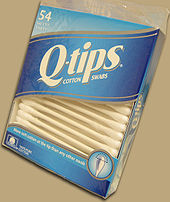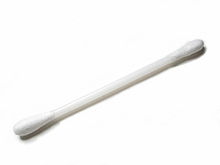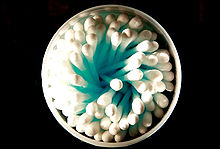Cotton swab
|
WikiDoc Resources for Cotton swab |
|
Articles |
|---|
|
Most recent articles on Cotton swab Most cited articles on Cotton swab |
|
Media |
|
Powerpoint slides on Cotton swab |
|
Evidence Based Medicine |
|
Clinical Trials |
|
Ongoing Trials on Cotton swab at Clinical Trials.gov Clinical Trials on Cotton swab at Google
|
|
Guidelines / Policies / Govt |
|
US National Guidelines Clearinghouse on Cotton swab
|
|
Books |
|
News |
|
Commentary |
|
Definitions |
|
Patient Resources / Community |
|
Patient resources on Cotton swab Discussion groups on Cotton swab Patient Handouts on Cotton swab Directions to Hospitals Treating Cotton swab Risk calculators and risk factors for Cotton swab
|
|
Healthcare Provider Resources |
|
Causes & Risk Factors for Cotton swab |
|
Continuing Medical Education (CME) |
|
International |
|
|
|
Business |
|
Experimental / Informatics |
Editor-In-Chief: C. Michael Gibson, M.S., M.D. [1]
Overview




Cotton swabs (British English: cotton buds) are used in first aid, cosmetics application, and a variety of other uses. They consist of a small wad of cotton wrapped around the end of a small rod, made of wood, rolled paper, or plastic. The most common type of usage is to dip the cotton end in a substance, then use the swab as an applicator for the substance. Sometimes swabs are also used for removal of substances such as wax from ear canals, though the instructions accompanying the swabs generally contain a warning that the swabs should not be inserted directly into the ear, as doing so is actually dangerous. Using a swab to remove wax can puncture the ear drum. It will remove only a fraction of the wax, which is visible on the removed swab, while pushing and packing the majority of the wax further into the ear canal.
The inventor of the cotton swab is supposed to have been one Leo Gerstenzang, in 1923 [2]. His product, which he named "Baby Gays", went on to become the most widely-sold brand name, "Q-tip".
The traditional cotton swab has a single tip on a wooden handle, and these are still often used, especially in medical settings. They are usually relatively long, about six inches (15 cm or so). These often are packaged sterile, one or two to a paper or plastic sleeve. The advantage of the paper sleeve and the wooden handle is that the package can be autoclaved to be sterilized (plastic sleeves or handles would melt in the autoclave).
These medical-type swabs are often used to take microbiological cultures. They are swabbed onto or into the infected area, then wiped across the culture medium, such as an agar plate, where any bacteria from the swab will grow. They are also used to take DNA samples from, most commonly, the inner cheek. As well, they can be used to apply medicines to a targeted area, to selectively remove substances from a targeted area, or to apply cleaning substances like Betadine.
Cotton swabs produced for home use are usually shorter, about three inches (7.6 cm) long, and usually double-tipped. The handles were first made of wood, then made of rolled paper, which is still most common (although tubular plastic is becoming popular). They are often sold in large quantities, possibly 300 or more to a container.
One recent innovation is to use a special type of double-tipped cotton swab for over-the-counter drug application. These swabs have hollow tubular plastic handles, which are full of the medicine. Breaking one marked end of the swab breaks an air seal, allowing the medicine to saturate the cotton at the other end so that it can be directly applied with the swab.
Swabs exist in a wide variety of colors: purple, fuchsia, pink, green etc. However the cotton itself is white.